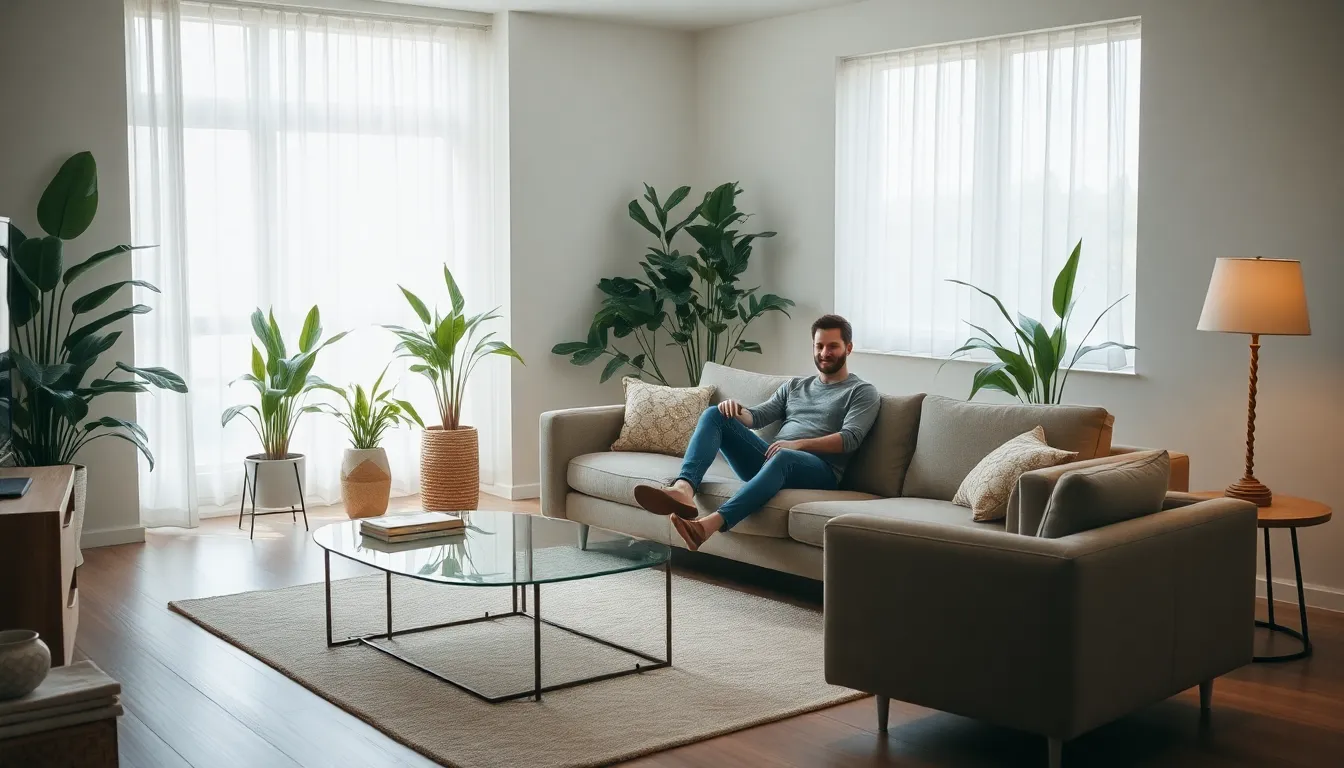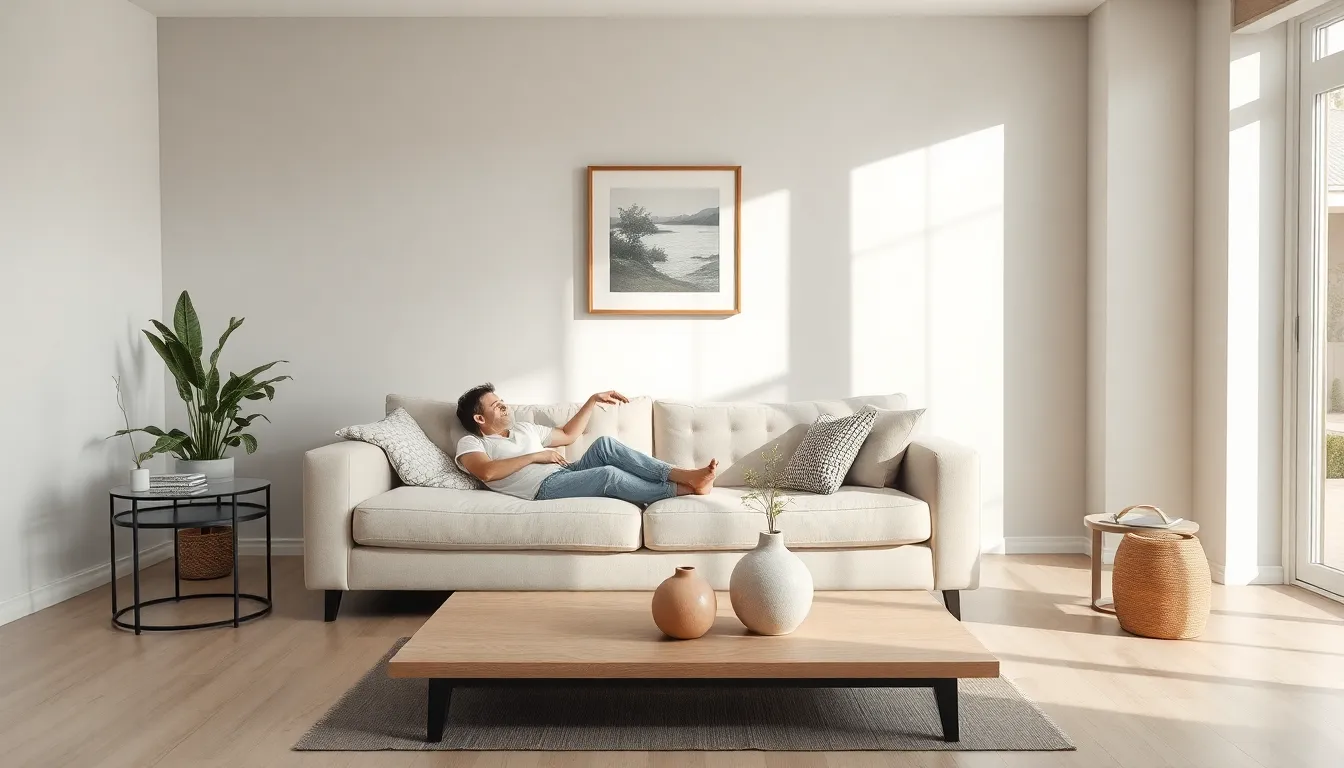In a world overflowing with stuff, embracing minimal decor feels like a breath of fresh air. Imagine walking into a space that whispers tranquility instead of shouting chaos. Minimalism isn’t just a design choice; it’s a lifestyle that transforms homes into serene sanctuaries.
Table of Contents
ToggleUnderstanding Minimal Decor
Minimal decor emphasizes simplicity while enhancing functionality. This design approach prioritizes essential elements, stripping away non-essential furnishings. Less clutter promotes a sense of calm, making spaces feel more open and inviting.
Neutral color palettes dominate minimal decor, creating a cohesive look. Whites, grays, and beiges often establish a serene backdrop. Bold accents may appear sparingly, adding depth without overwhelming the senses.
Furniture pieces in minimal decor exhibit clean lines and organic shapes. Each piece serves a practical purpose, contributing to the overall aesthetic. Natural materials such as wood and stone frequently appear, bringing warmth to the environment.
Lighting plays a crucial role in minimal decor. Well-placed fixtures can create an airy atmosphere while highlighting key design elements. Large windows maximize natural light, further enhancing the open feeling of a space.
Personal items in minimal decor reflect personality yet maintain visual simplicity. Carefully curated artworks or decorative objects infuse spaces with character without cluttering. Each chosen item serves a dual purpose, providing both beauty and function.
Embracing minimal decor encourages mindfulness. Living intentionally with fewer possessions fosters appreciation for what one owns. This approach cultivates a tranquil environment conducive to relaxation and focus.
Ultimately, minimal decor creates balanced, harmonious spaces. By emphasizing simplicity and functionality, it transforms living areas into calming sanctuaries.
Benefits of Minimalism in Decor

Minimalism in decor offers multiple advantages that contribute to a more serene living environment. Emphasizing simplicity, it fosters clarity and focus throughout the home.
Enhanced Clarity and Focus
Clarity results from reducing visual distractions. Spaces become more inviting when they showcase only essential furniture and decor items. Clean lines help the eye navigate the environment effortlessly. An organized setting encourages mental clarity, enhancing productivity and focusing on tasks. Each piece within the space serves a purpose, eliminating unnecessary clutter. Homeowners often report feeling more content in streamlined spaces. This clarity promotes overall well-being, making minimalism an ideal choice for those aiming for tranquility.
Reduced Stress and Clutter
Stress diminishes when clutter disappears. Minimalism simplifies daily routines, making it easier to maintain an orderly home. A clean environment allows for deeper relaxation and mental rejuvenation. Spaces filled with essentials rather than excess create a sense of calm. This approach to decor encourages individuals to appreciate their belongings, retaining only what is meaningful. By limiting distractions, minimalism supports a peaceful atmosphere conducive to better mental health. Ultimately, reduced clutter leads to an improved quality of life, which is a key hallmark of minimalist decor.
Essential Minimal Decor Tips
Minimal decor thrives on simplicity and intentionality. Applying some essential tips can enhance the tranquility of a space.
Choose a Neutral Color Palette
A neutral color palette creates a calming environment. Whites, grays, and beiges not only maximize light but also provide a serene backdrop for bold accents. Soft tones foster a sense of cohesiveness, allowing for seamless transitions between different areas. Layering various neutral shades can add depth while maintaining an inviting atmosphere. This strategy emphasizes peace over chaos, contributing to a more relaxed living space.
Invest in Quality Over Quantity
Choosing quality over quantity enhances the effectiveness of minimal decor. Selecting a few well-crafted pieces can create a significant impact. Furniture made from durable materials such as wood or stone adds warmth and character. Each item should serve a purpose, ensuring it contributes positively to the overall aesthetic. Investing in high-quality accessories leads to lasting satisfaction and reduces the need for frequent replacements, promoting a sustainable lifestyle.
Embrace Open Spaces
Open spaces promote an airy and expansive feel. Removing unnecessary furniture fosters freedom of movement, enhancing overall comfort. Greater flow between areas encourages social interaction and invites natural light. A well-arranged layout can make even small spaces feel more significant. Using furniture that complements the available space allows for a harmonious balance, creating environments that nurture well-being.
Limit Decorative Accessories
Limiting decorative accessories helps maintain visual clarity. Each decorative item should hold meaning or purpose, avoiding clutter. Select unique pieces that express individuality while adhering to the minimal aesthetic. Grouping similar items can create focal points without overwhelming the senses. Prioritizing simplicity ensures that spaces remain tranquil and functional, reinforcing the essence of minimalism.
Creating a Minimalist Atmosphere
Creating a minimalist atmosphere enhances the sense of calm and openness within a space. Thoughtful design choices focus on minimalism’s essence, refining interiors to promote tranquility.
Balance Functionality and Aesthetics
Functionality and aesthetics work together to achieve minimalist decor. Each piece of furniture should serve a purpose, whether it’s a sleek coffee table or a comfortable chair. Emphasizing clean lines and uncluttered forms enhances visual appeal. Space management becomes essential; choosing multifunctional furnishings, such as a sofa bed, maximizes utility. By prioritizing quality, individuals can create an elegant environment that feels curated yet accessible. Affordability often connects with functionality; thus, selecting well-made items with longevity in mind boosts overall design integrity. Visitors will appreciate the thoughtful balance that combines beauty with practical use.
Incorporate Natural Elements
Natural elements foster warmth and tranquility within minimalist spaces. Wood and stone materials add organic textures that soften harsh lines. Incorporating plants enhances the environment’s freshness and liveliness, providing a vibrant contrast to neutral palettes. Arrangement styles matter as well; placing greenery in varying heights creates visual interest. Light-filled areas celebrate outdoor views, blurring the lines between indoors and outdoors. Textiles like cotton or linen bring softness, maintaining comfort without overwhelming visual clarity. Introducing these elements helps create an inviting and serene setting that reflects nature’s beauty.
Minimal decor isn’t just a design choice; it’s a lifestyle that promotes tranquility and clarity. By focusing on simplicity and functionality, individuals can create serene spaces that enhance well-being and foster mindfulness. Choosing neutral palettes and quality furnishings allows for a cohesive atmosphere that feels both inviting and purposeful.
Incorporating natural elements and maximizing light can further elevate these environments, making them not only beautiful but also practical. Embracing minimalism encourages a deeper appreciation for one’s belongings, leading to a more fulfilling and organized life. As homeowners adopt these principles, they’ll find their living spaces transforming into peaceful sanctuaries that nurture both body and mind.



